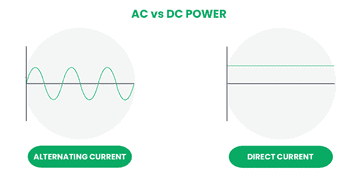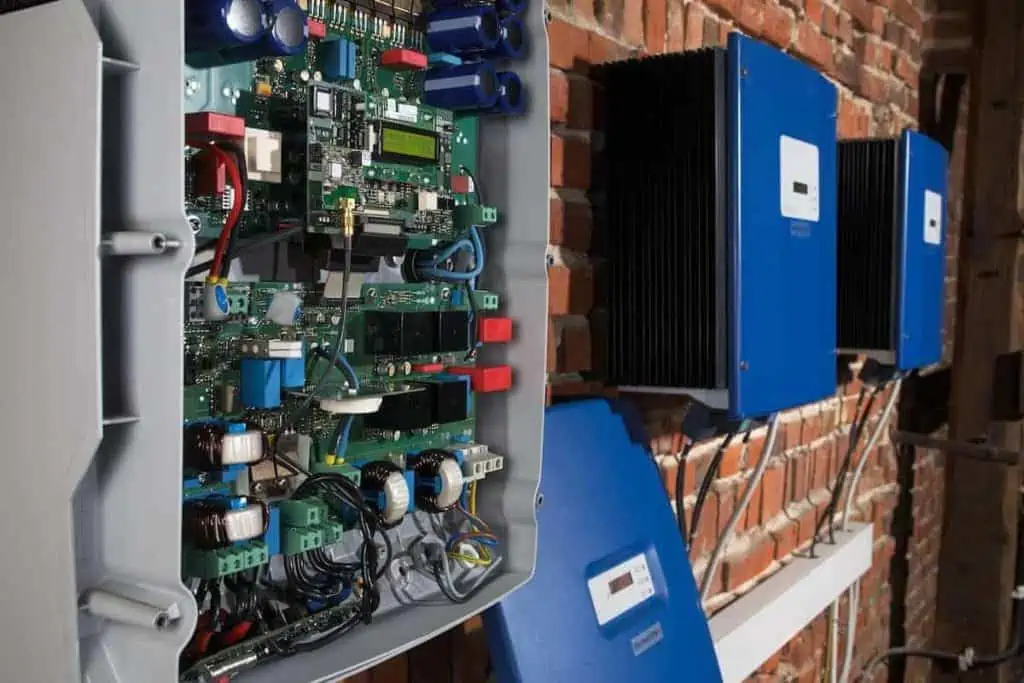Want to see the most common questions homeowners have when going solar and how to address them? Check out our 2025 Homeowner Guide to Going Solar.
Table of contents
- The difference between AC vs DC
- The war of the currents: AC vs DC
- Do household items use DC or AC?
- AC vs DC for solar panels
- What about AC solar panels?
- Advantages and disadvantages of DC in solar
- Advantages and disadvantages of AC in solar
- What about battery storage?
In the solar industry, producing electricity is our bread and butter. This means it’s important for solar professionals to have a strong grasp of electricity fundamentals.
If you’re new to solar, there’s a lot to learn — you can’t just plug the panels into the wall and call it a day. In today’s article, we cover one of the core topics every installer needs to understand about electricity: the difference between AC and DC, the two types of electric current.
AC and DC are both involved in solar systems. So, if your familiarity with AC/DC starts and ends with the famous band, this article is for you!
DC vs AC: The difference between alternating current (AC) and direct current (DC)
AC stands for alternating current and DC for direct current. AC and DC power refer to the current flow of an electric charge. Each represents a type of “flow,” or form, that the electric current can take.
Although it may sound a bit technical, the difference between AC and DC is fairly basic:
- Direct current (DC) always flows in the same direction.
- Alternating current (AC), as you might expect from the name, changes direction frequently — 60 times per second in the U.S. (though the back-and-forth motion of the electrons still conveys energy to the end device).
“A simple way to visualize the difference [between AC and DC] is that, when graphed, a DC current looks like a flat line, whereas the flow of AC on a graph makes a sinusoid or wave-like pattern,” says Karl K. Berggren, professor of electrical engineering at MIT.

The war of the currents: The fight between DC and AC
When electric power was first being developed and used in the late 1880s, it was unclear whether AC or DC would become the dominant way electricity was supplied. Two famous pioneers of electricity — Thomas Edison and Nikola Tesla — each advanced one of these options.
Edison had developed DC first, so electricity that ran continuously in one direction was the standard in the U.S. during the early years of electricity. However, one issue with DC is that it’s not easily converted to higher or lower voltages — which is obviously useful for different applications.
Tesla believed he had the solution to this problem and patented AC, which can be converted to different voltages using transformers, and it’s also easier to transmit AC power over long distances.
Of course, Edison didn’t want to lose out on his royalties, so he started a misinformation campaign to discredit AC as dangerous (in which he went so far as to publicly electrocute animals!).
At the peak of this “War of the Currents” was the Chicago World’s Fair of 1893. General Electric placed a bid to provide electricity for the fair using Edison’s DC, but lost to George Westinghouse, who said he could power the fair for $155,000 less using Tesla’s AC.
Slowly but surely, power companies started to realize the benefit of using AC, and by the late 1890s, it had become the more dominant source of energy, and remains so to this day. However, DC is still used for devices like computers, solar cells, and electric vehicles.
Do household items use DC or AC?
The short answer is, “both”. The U.S. electric grid and the power flowing into your home are AC. As a result, most plug-in home appliances — refrigerators, electric ovens, microwaves, and so on — run on AC power.
Batteries, however, use direct current: They have a positive and negative terminal, and current always flows in the same direction between those points — from the positive to negative terminals — when they’re being discharged.
Because batteries are DC, many of the electronics you use — like your laptop and cell phone — run on DC as well.
Is solar power AC or DC?
Solar panels produce direct current: The sun shining on the panels stimulates the flow of electrons in a single direction, creating a direct current.

The need for inverters
Because solar panels generate direct current, solar PV systems need to use inverters. The inverter converts DC energy into AC energy so that electricity can be used in the home or sent back to the electric grid (in addition to some other functions).
What about those DC-powered devices? Well, the power adapter that’s part of the charger for these devices is, in fact, a form of inverter. They convert the AC grid supply to DC power that can be used by the device.
So, when you plug in your laptop in your solar-powered home, the DC power from the solar panels is converted to AC by your inverter, it’s then turned back into DC by your laptop’s inverter, so your laptop can use it to charge.
That may seem like a lot. Thankfully, there’s solar software out there that can help ease the burden when actually putting these concepts into practice with solar system design. This solar software buyer’s guide details some of the features you should look for when considering a solution.
What about AC solar panels?
As we discussed above, technically all solar panels produce DC energy. That energy is then converted to AC power by the inverter. This is the case whether your PV system includes a string inverter (which converts energy from one or multiple strings of solar panels) or microinverters (which convert it for individual, or in some cases a few, solar panels).
However, you may also have heard of AC solar panels. But if solar panels inherently produce DC, how can this be?
What are AC solar panels?
AC panels are simply solar panels that have microinverters integrated into them. System design using AC panels is similar to designing a system with microinverters, except that the installer doesn’t need to buy and attach the microinverters separately.
Advantages and disadvantages of DC solar panels
Again, technically all solar panels are DC panels because that’s how the panels work — they all produce a flow of electrons in one direction. As such, many panels on the market are DC panels. There are some pros and cons to buying DC solar panels.
Advantages of DC in solar
Safety: Edison may have taken his smear campaign against AC a little too far, but he was onto something. DC voltage is considered safer than AC because it doesn’t have as much of a risk of electrocution or shock.
Accessibility: There’s a wider array of DC solar panels on the market, which also means DC solar panels tend to be cheaper compared to AC solar panels.
Battery storage efficiency: DC-coupled battery storage systems are more efficient compared to AC because the electricity is converted from DC to AC only once.
Disadvantages of DC in solar
Extra conversion: Because your home and appliances run on AC power, a separate inverter is needed to convert the energy from DC to AC to be used.
Limited distance: As was discovered back during the Current War, DC electricity has a significantly limited distance before it experiences a drop in voltage compared to AC electricity.
More complicated solar storage installation: DC-coupled battery systems can be more complicated to install, which may drive up installation costs.
Advantages and disadvantages of AC solar panels
As explained, AC solar panels aren’t really AC solar panels, but rather DC solar panels that have built-in microinverters so they can produce AC electricity. There are pros and cons to buying AC solar panels as well.
Advantages of AC solar panels
Ease of installation: AC solar panels don’t need DC wiring or to go through a separate, standalone inverter, reducing material needs and install time.
Ease of solar storage installation: If you already have a solar system, installing an AC-coupled battery storage solution can be very straightforward, which means a cheaper and less time consuming battery installation.
Ease of expansion: If you want to expand a traditional (DC) solar system, you will also need a new inverter that can handle the additional load (assuming the inverter was sized correctly at the start). AC panels don’t have a central inverter, so you can simply add them.
Disadvantages of AC solar panels
More expensive: Because of the built-in microinverter, AC solar panels tend to be more expensive compared to DC panels.
Inverters exposed: With traditional DC panels, your panels will be outside on the roof, while your inverter will likely be in a more protected area. But with AC solar panels, the inverters are built into the back of the panel, meaning they’re more exposed to the elements and therefore at higher risk of damage.
Maintenance: If there’s a conversion issue with a DC solar PV system, a solar technician can go to the inverter to identify the issue. But with AC solar panels, each panel is fitted with its own inverter, potentially making it harder to identify which panel might be acting up.
What about battery storage?
Home storage batteries connected to solar use the same general model. DC batteries run power through an inverter to convert it to AC. “AC batteries” on the market simply have a built-in inverter that lets them convert DC directly into AC.
Understanding the differences between AC and DC is important in the solar industry. Not only is it essential to understanding how a solar array works and how it’s designed, this knowledge can also help you educate customers and ultimately build trust during the sales process.
Ready to learn more? Check out our battery storage information page.
This blog was originally published in February 2021. It was updated in October 2024 to reflect the most recent information. If you have any questions, please contact us.